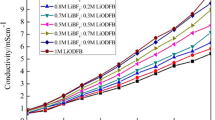Abstract
This paper discusses the electrolyte distribution over the surface of a 4.5 V LiCoO2 electrode via linear sweep voltammetry using the Pt probe of a scanning electrochemical microscope. On a typical electrolyte composition for Li-ion batteries (LIBs), 1.0 M LiPF6 EC/DEC (3/7, vol. %), the reduction peak of non-solvated free-ethylene carbonate (EC) increased, and the peak of diethyl carbonate (DEC) decreased as the Pt probe approaching the oxidizing LiCoO2 substrate. When the salt concentration increased, the reduction current by the free-EC decreased as the Pt probe approaching the substrate. By adding 1,3,5-trifluorobenzene as an electrolyte additive, the separation of these two reduction peaks became unclear, and the variation of the peak current almost disappeared closer to the oxidizing electrode. Compared to their electrochemical performance for LIBs, the electrolyte distribution measured by the Pt probe over the electrode surface has a relationship with electrolyte decomposition at the 1st charging process, charge transfer resistance (Rct) at the electrode interface, electrolyte impregnation into the coated electrode, and electrochemical performances of LIBs.






Similar content being viewed by others
Change history
23 May 2022
A Correction to this paper has been published: https://doi.org/10.1007/s10008-022-05191-1
References
Endo M, Takeda T, Kim YJ, Koshiba K, Ishii K (2001) High power electric double layer capacitor (EDLC’s); from operating principle to pore size control in advanced activated carbons. Carb Sci 1:117–128
Li M, Lu J, Chen Z, Amine K (2018) 30 years of lithium-ion batteries. Adv Mater 30:1800561
Peled E, Menkin S (2017) Review-SEI: past, present and future. J Electrochem Soc 164:A1703–A1719
Hussain S, Yangping L (2020) Review of solid oxide fuel cell materials: cathode, anode, and electrolyte. Energy Transit 4:113–126
Zhang H, Li Y, Zhang X, Zhang Y, Zhou H (2020) Role of interface properties in organic solar cells: from substrate engineering to bulk-heterojunction interfacial morphology. Mater Chem Front 4:2863–2880
Kim T, Song W, Son DY, Ono LK, Qi Y (2019) Lithium-ion batteries: outlook on present, future, and hybridized technologies. J Mater Chem A 7:2942–2964
Peled E (1979) The electrochemical behavior of alkali and alkaline earth metals in nonaqueous battery systems - the solid electrolyte interphase model. J Electrochem Soc 126:2047–2051
Wang A, Kadam S, Li H, Shi S, Qi Y (2018) Review on modeling of the anode solid electrolyte interphase (SEI) for lithium-ion batteries. Npj Comput Mater 15:1–26
Abakumov AM, Fedotov SS, Antipov EV, Tarascon JM (2020) Solid state chemistry for developing better metal-ion batteries. Nat Commun 11:4976
Gu Y, Wang WW, Li YJ, Wu QH, Tang S, Yan JW, Zheng MS, Wu DY, Fan CH, Hu WQ, Chen ZB, Fang Y, Zhang QH, Dong QF, Mao BW (2018) Designable ultra-smooth ultra-thin solid-electrolyte interphases of three alkali metal anodes. Nat Commun 9:1339
Maibach J, Xu C, Eriksson SK, Åhlund J, Gustafsson T, Siegbahn H, Rensmo H, Edström K, Hahlin M (2015) A high pressure x-ray photoelectron spectroscopy experimental method for characterization of solid-liquid interfaces demonstrated with a Li-ion battery system. Rev Sci Instrum 86:044101
Zhuang GV, Yang H, Blizana B, Ross PN Jr (2005) A study of electrochemical reduction of ethylene and propylene carbonate electrolytes on graphite using ATR-FTIR spectroscopy. Electrochem Solid-State Lett 8:A441–A445
Leifer N, Smart MC, Prakash GKS, Gonzalez L, Sanchez L, Smith KA, Bhalla P, Grey CP, Greenbaum SG (2011) 13C solid state NMR suggests unusual breakdown products in SEI formation on lithium ion electrodes. J Electrochem Society 158:A471–A480
Lu D, Tao J, Yan P, Henderson WA, Li Q, Shao Y, Helm ML, Borodin O, Graff GL, Polzin B, Wang CM (2017) Formation of reversible solid electrolyte interface on graphite surface from concentrated electrolytes. Nano Lett 17:1602–1609
Xu K (2014) Electrolytes and interphases in Li-ion batteries and beyond. Chem Rev 114:11503–11618
Rikka VR, Sahu SR, Chatterjee A, Satyam PV, Prakash RM, Rao SR, Gopalan R, Sundararajan G (2018) In situ/ex situ investigations on the formation of the mosaic solid electrolyte interface layer on graphite anode for lithium-ion batteries. J Phys Chem C 122:28717–28726
Zhang X, Meng J, Wang X, Xiao Z, Wu P, Mai L (2021) Comprehensive insights into electrolytes and solid electrolyte interfaces in potassium-ion batteries. En Stor Mater 38:30–49
Ventosa E, Schuhmann W (2015) Scanning electrochemical microscopy of Li-ion batteries. Phys Chem Chem Phys 17:28441–28450
Baek B, Jung C (2010) Enhancement of the Li+ ion transfer reaction at the LiCoO2 interface by 1, 3, 5-trifluorobenzene. Electrochim Acta 55:3307–3311
Xu F, Beak B, Jung C (2012) In situ electrochemical studies for Li+ ions dissociation from the LiCoO2 electrode by the substrate-generation/tip-collection mode in SECM. J Solid State Electrochem 16:305–311
Wang Y, Nakamura S, Ue M, Balbuena PB (2001) Theoretical studies to understand surface chemistry on carbon anodes for lithium-ion batteries: reduction mechanisms of ethylene carbonate. J Am Chem Soc 123:11708–11718
Zhuang QC, Wei T, Du LL, Cui YL, Fang L, Sun SG (2010) An electrochemical impedance spectroscopic study of the electronic and ionic transport properties of spinel LiMn2O4. J Phys Chem C 114:8614–8621
Funding
This work was supported by the 2021 Research Fund of the University of Seoul.
Author information
Authors and Affiliations
Corresponding author
Ethics declarations
Conflict of interest
The authors declare no competing interests.
Additional information
Publisher's Note
Springer Nature remains neutral with regard to jurisdictional claims in published maps and institutional affiliations.
Rights and permissions
About this article
Cite this article
Jung, C. Effect of electrolyte components, salt concentration, and electrolyte additive, on electrolyte distribution over a charging LiMO2 electrode. J Solid State Electrochem 26, 1469–1475 (2022). https://doi.org/10.1007/s10008-022-05178-y
Received:
Revised:
Accepted:
Published:
Issue Date:
DOI: https://doi.org/10.1007/s10008-022-05178-y




